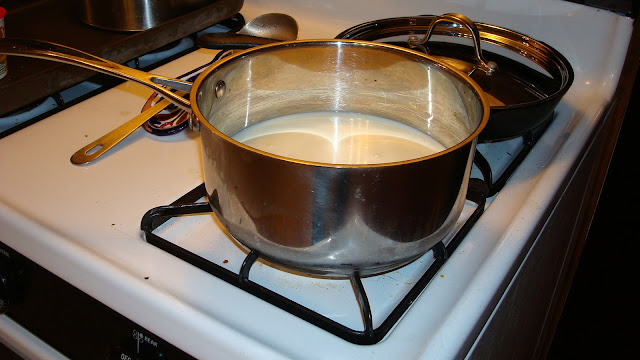Strata is essentially a layered breakfast "casserole" with milk, cream, cheese, eggs, bread, herbs and veggies and/or meat. Thank you again to Andy's mom, I received the cookbook, Eggs: Fresh, Simple Recipes For Frittatas, Omelets, Scrambles and More by Jodi Liano, for Christmas. My hens started laying eggs around Thanksgiving, so this was the perfect gift!
I used the Herbed Tomato Strata recipe as my guide. I say guide, as I'm not one to strictly follow recipes.
Ingredients (according to what I used):
6 eggs (from my hens)
2 cups of whole milk (from the dairy)
1 cup of heavy cream
2 tbsp freshly grated parmesan
1 tbsp chopped fresh thyme (from my garden)
1/4 cup chopped fresh parsley (from my garden)
1 baguette, sliced in 1/2 inch portions
1 1/2 cups gruyere
1 yellow roasted sweet pepper, chopped
2 cups chopped baby bella mushrooms, sauteed in butter
4 smoked tomatoes (from my friend's garden), chopped
Dash of salt and pepper
 |
| Mise en place |
I used 1 1/2 cups of gruyere (as opposed to the 2 cups of mozzarella the original recipe called for) because I find mozzarella to be quite boring. Also, because it is a stronger-flavored cheese, I use less. The original recipe called for fresh tomatoes, which I refuse to buy until tomato season, so I chose mushrooms and [jarred] roasted yellow pepper. Luckily, I had some of my friend's homegrown and smoked tomatoes. Just adding a few to any dish really gives it that smokey flavor. I used more parsley than the original recipe calls for because I have it in my garden and because I like it!
Directions:
Butter a 9 x 13 in glass baking dish. In a bowl, whisk together the eggs, milk, cream, Parmesan, thyme, parsley and dash of salt and pepper.
Arrange half of the sliced bread on the bottom of the backing dish. Top with half of the egg mixture, half of the gruyere cheese, half of the mushrooms, pepper and smoked tomatoes.
 |
| First layer of bread, cheese, veggies |
 |
| Complete first layer |
Repeat the layering, using all the remaining ingredients. Let the strata stand for 20 minutes at room temperature, occasionally pressing the ingredients with a spatula to keep the bread well coated.
 |
| Ready to go in the oven |
Preheat the oven to 350. Baked the strata until golden brown, puffed, and set, about 45 - 60 minutes. Halfway through the cooking time, remove the strata from the oven and press on the top layer of bread, keeping it submerged in the custard (OOPs, I didn't do this). Let the strata rest for about 10 minutes upon removing it from the oven. Cut into squares and serve right away.
 |
| The strata is done! |
I plan to eat this throughout the week, let's see how long it lasts :)













